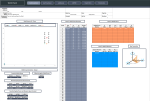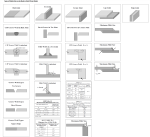Weld Check

Description
Weld Check is a spreadsheet program written in MS-Excel for the purpose of analysis of 2D weld groups using the 'elastic' (vector) method. ('Alternate Method 1' in AISC Manual 14th Edition). The elastic method used in this program differs slightly from that of the method used in AISC standards and is an extension of the same method produced by Dr Shaig Khan.
The user can create different types fillet, CJP, or PJP welds. Program calculates throat lenghts based on weld shapes.
User can create material and filler databases.
Program calculates allowable stress and strength based on AWS, AA, and AISC standards.
The elastic (vector) method is an approach used to determine the load-carrying capacity of 2D weld groups subjected to direct, shear, and bending loads. In this method, the forces acting on each individual weld are represented as vectors, and then summed up to determine the overall force on the weld group.
Here are the steps to calculate the load-carrying capacity of a 2D weld group using the elastic (vector) method:
-
Identify the weld group geometry and the applied forces: Determine the weld group's geometry, including the number of welds, weld sizes, and arrangement. Identify the applied force (P) and its line of action, as well as any additional bending moments (M) or shear forces (V) acting on the weld group.
-
Calculate the load eccentricity and moment: Determine the distance (e) between the applied force's line of action and the centroid of the weld group, and calculate the moment (M) caused by the eccentric load using the formula:
M = P * e
-
Determine the forces acting on each weld: For each weld in the group, calculate the direct (axial) force (F_axial), shear force (F_shear), and bending moment (M_b) acting on that weld. The axial and shear forces can be determined by resolving the applied force (P) into its components, and the bending moment can be calculated by dividing the total moment (M) by the number of welds.
-
Calculate the stress on each weld: For each weld, determine the axial stress (σ_axial), shear stress (τ_shear), and bending stress (σ_bending) using the following formulas:
σ_axial = F_axial / A τ_shear = F_shear / A σ_bending = M_b * c / I
Where: A = Cross-sectional area of the weld c = Distance from the neutral axis to the outermost fiber of the weld I = Moment of inertia of the weld cross-section
- Determine the equivalent stress on each weld: For each weld, calculate the equivalent stress (σ_equiv) by combining the axial, shear, and bending stresses using the following formula:
σ_equiv = √(σ_axial^2 + 3 * τ_shear^2 + σ_bending^2)
-
Compare the equivalent stress to the allowable stress: Determine the allowable stress (σ_allow) for the weld material, and compare the equivalent stress (σ_equiv) to the allowable stress (σ_allow) for each weld. If the equivalent stress exceeds the allowable stress for any weld, the weld group does not have sufficient capacity for the applied load.
-
Check the weld group's capacity: If the equivalent stress (σ_equiv) is less than or equal to the allowable stress (σ_allow) for all welds in the group, the weld group has sufficient capacity to carry the applied load.
The elastic (vector) method provides a comprehensive approach to determining the load-carrying capacity of 2D weld groups, accounting for the effects of direct, shear, and bending loads acting on the welds.
Calculation Preview
Full download access to any calculation is available to users with a paid or awarded subscription (XLC Pro).
Subscriptions are free to contributors to the site, alternatively they can be purchased.
Click here for information on subscriptions.








